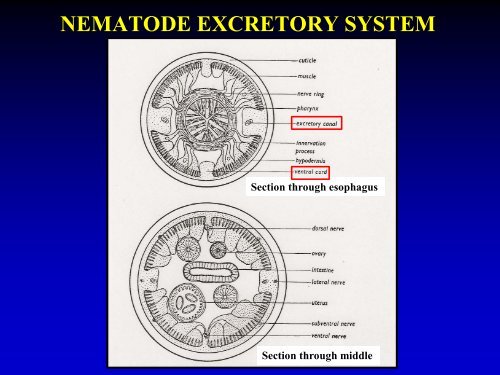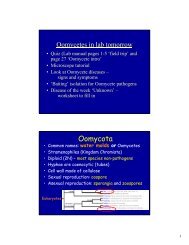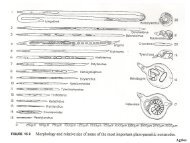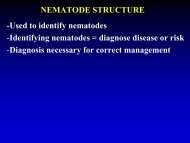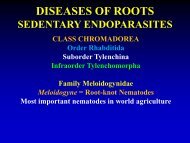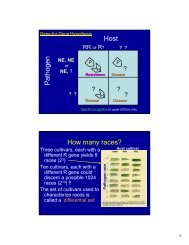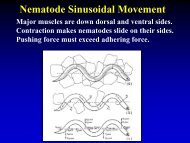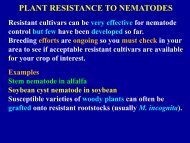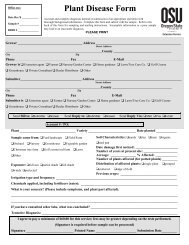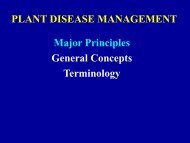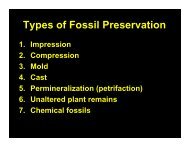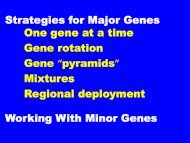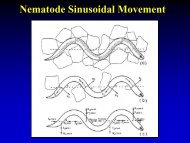NEMATODE EXCRETORY SYSTEM
NEMATODE EXCRETORY SYSTEM
NEMATODE EXCRETORY SYSTEM
Create successful ePaper yourself
Turn your PDF publications into a flip-book with our unique Google optimized e-Paper software.
<strong>NEMATODE</strong> <strong>EXCRETORY</strong> <strong>SYSTEM</strong><br />
Section through esophagus<br />
Section through middle
<strong>NEMATODE</strong> <strong>EXCRETORY</strong> <strong>SYSTEM</strong><br />
Excretory canals run through lateral hypodermal cords.<br />
Different systems = “H” (A, B), “U” (C), and tylenchoid (D).<br />
A single “renette cell” (E) is present in Dorylaimda.
<strong>NEMATODE</strong> PHYSIOLOGY<br />
<strong>EXCRETORY</strong> <strong>SYSTEM</strong><br />
Excretion of Nitrogenous Waste Products<br />
-Ammonia, urea, or uric acid<br />
-Amino acids, amines, peptides & fatty acids<br />
-Aquatic organisms = live in soil water<br />
-Ammonia toxic but diffuses away in soil water<br />
-Urea, nucleic acids, etc.<br />
Diffuse through body wall<br />
Voided through intestine, excretory system<br />
Stored in crystalline state
<strong>NEMATODE</strong> PHYSIOLOGY<br />
<strong>EXCRETORY</strong> <strong>SYSTEM</strong><br />
Other Functions<br />
-Osmoregulation<br />
-Removing excess water<br />
-Regulating turgor in body cavity<br />
-General “cleanup”, removes foreign particles<br />
-Releases enzyme-containing secretions<br />
a) Exodigestive enzymes<br />
b) Protective coatings<br />
c) Assist molting
<strong>NEMATODE</strong> PHYSIOLOGY<br />
RESPIRATION<br />
Nematodes are aerobic organisms<br />
-Require oxygen for metabolism<br />
-Thin shape and semipermeable cuticle<br />
-Width of nematode restricted by diffusion<br />
-Oxygen availability and demand depend on:<br />
1) O 2 concentration in environment<br />
2) Diffusion of O 2 into microsite<br />
3) Metabolic demand from<br />
body size, activity, temperature, starvation
<strong>NEMATODE</strong> PHYSIOLOGY<br />
RESPIRATION<br />
When oxygen is insufficient, nematodes<br />
-Decrease rate of development<br />
-Stop moving<br />
-Enter cryptobiosis
<strong>NEMATODE</strong> PHYSIOLOGY<br />
RESPIRATION<br />
Many nematodes are facultative anaerobes<br />
-Persist through microaerobic (30 days!
<strong>NEMATODE</strong> PHYSIOLOGY<br />
RESPIRATION<br />
Oxidative metabolism preferred<br />
1) More energy produced<br />
2) Toxic waste products produced from<br />
fermentative metabolism<br />
O 2 uptake is reduced as O 2 levels decline from<br />
normal air (21%) to 5%.<br />
At
<strong>NEMATODE</strong> PHYSIOLOGY<br />
MOLTING<br />
As nematodes grow they need to shed their<br />
cuticle to increase in size.<br />
Nematodes generally go through 4 molts.<br />
J1 J2 J3 J4 Adult<br />
Timing of molting depends on “stage of<br />
development”(physiological age), not necessarily<br />
chronological age, so each stage tends to be a<br />
certain size for a given species.
<strong>NEMATODE</strong> PHYSIOLOGY<br />
MOLTING<br />
Just before molting begins, the<br />
nematode stops feeding and<br />
becomes sluggish or inactive.<br />
A = Normal cuticle.<br />
B = Initial stages of molting,<br />
the hypodermis thickens<br />
C = Hypodermis secretes new<br />
cuticle under the old one
The basal part of the old stylet dissolves and slow<br />
retractile movements disengage the head from the<br />
anterior part of the old stylet, which remains<br />
attached to the anterior part of the old cuticle.
<strong>NEMATODE</strong> PHYSIOLOGY<br />
MOLTING<br />
D = Two cuticles separate and a<br />
space develops between them.<br />
Folds may appear in the old<br />
cuticle as it enlarges and<br />
becomes loose.<br />
E = Most of the old cuticle is<br />
reabsorbed before it is shed.<br />
F = The old external cortex is<br />
not reabsorbed and is the only<br />
part of the cuticle cast off.
<strong>NEMATODE</strong> PHYSIOLOGY<br />
MOLTING<br />
The nematode breaks out of the old cuticle by<br />
"rubbing" against soil particles.<br />
New cuticle is convoluted to allow for rapid<br />
growth, increase in thickness.<br />
The entire cuticle is shed including the lining<br />
of the stoma, esophagus, vulva, cloaca, &<br />
rectum.<br />
New cuticular structures are formed.
<strong>NEMATODE</strong> PHYSIOLOGY<br />
SENESCENCE, QUIESCENCE & CRYPTOBIOSIS<br />
Normal life spans for<br />
most individuals of a<br />
given species are similar.<br />
Normal aging process:<br />
= Senescence
<strong>NEMATODE</strong> PHYSIOLOGY<br />
SENESCENCE, QUIESCENCE & CRYPTOBIOSIS<br />
When environment shifts unfavorably<br />
nematodes experience metabolic “slowdown”<br />
= Quiescence<br />
Movement slows or stops, life cycle<br />
development delayed.<br />
Metabolism slowed, but still detectable.
<strong>NEMATODE</strong> PHYSIOLOGY<br />
SENESCENCE, QUIESCENCE & CRYPTOBIOSIS<br />
Increase or prolonged environmental stress<br />
leads to metabolic “shutdown”<br />
= Cryptobiosis<br />
Metabolism is not detectable!
<strong>NEMATODE</strong> PHYSIOLOGY<br />
SENESCENCE, QUIESCENCE & CRYPTOBIOSIS<br />
Physiological aging slows in quiescent nematodes.<br />
64-day-old quiescent Meloidogyne javanica = physiological age of 4 days.<br />
128-day-old Tylenchulus semipenetrans had aged 16 days.<br />
Aphelenchus avenae under O 2 stress for 90 days had not aged at all.
<strong>NEMATODE</strong> PHYSIOLOGY<br />
SENESCENCE, QUIESCENCE & CRYPTOBIOSIS<br />
Several environmental conditions may induce nematodes<br />
to enter a quiescent or cryptobiotic state.<br />
Anhydrobiosis = condition due to lack of water.<br />
Cryobiosis = caused by lowering of temperature.<br />
Anoxybiosis = absence or low levels of oxygen.<br />
Osmobiosis = removal of water from organisms by a<br />
solution that has high osmotic potential.<br />
Several may occur a same time.<br />
Anhydrobiosis most common.
<strong>NEMATODE</strong> PHYSIOLOGY<br />
SENESCENCE, QUIESCENCE & CRYPTOBIOSIS<br />
Induction of anhydrobiosis due to slow<br />
dehydration includes physical and physiological<br />
responses to resist desiccation.<br />
Physical response = coiling into a spiral reduces<br />
the surface area exposed to the environment<br />
and reduces the rate of water loss.<br />
When dried straight, nematodes have little<br />
control of water loss, lose water to quickly.
Aphelenchus avenae in anhyrobiosis<br />
Coiling = physical response<br />
M.A. McClure
<strong>NEMATODE</strong> PHYSIOLOGY<br />
SENESCENCE, QUIESCENCE & CRYPTOBIOSIS<br />
Some nematodes swarm into a mass that also<br />
helps protect them from rapid water loss.<br />
At times, a lipid layer surrounding the cuticle<br />
causes the swarm to clump and stick together<br />
(= nematode wool).<br />
Nematodes inside plant tissues are further<br />
protected.
Swarm of Anquina tritici juveniles<br />
in anhydrobiotic state<br />
M.A. McClure
Ditylenchus dipsaci J4 – nematode wool on basal plate<br />
defra<br />
defra
<strong>NEMATODE</strong> PHYSIOLOGY<br />
SENESCENCE, QUIESCENCE & CRYPTOBIOSIS<br />
Physiological Responses – Water Dynamics<br />
Active nematode = 75-80% water.<br />
Anhydrobiotic in dry air (0% rh) is 2-5% water.<br />
Water lost by dehydration (80% -> 5%) is<br />
"free water" = used in metabolic processes and<br />
in cytoplasm. Can be lost without cell damage.<br />
The 2-5% water remaining is "bound water"<br />
and is essential for the maintenance of<br />
membranes and other structural components.
<strong>NEMATODE</strong> PHYSIOLOGY<br />
SENESCENCE, QUIESCENCE & CRYPTOBIOSIS<br />
Physiological Responses – Metabolic Changes<br />
During dehydration<br />
- lipid concentration decreases<br />
- trehalose (a non-reducing sugar) increases 7X<br />
- glycerol concentration increases substantially<br />
Glycerol replaces bound water in stabilizing<br />
membrane structure.<br />
"Quick dried" nematodes do not synthesize<br />
glycerol, membranes destabilize, and nematode<br />
dies.
<strong>NEMATODE</strong> PHYSIOLOGY<br />
SENESCENCE, QUIESCENCE & CRYPTOBIOSIS<br />
Resistance to Unfavorable Conditions<br />
Cryptobiotic = resistant to harsh environment<br />
Don’t want conditions that would induce<br />
cryptobiosis before you treat!<br />
Examples:
<strong>NEMATODE</strong> PHYSIOLOGY<br />
RESISTANT STAGES<br />
In some nematodes only one life stage from egg<br />
to adult is resistant. Can be any stage.<br />
In other species, any stage from the J2 to adult<br />
can successfully enter and exit cryptobiosis.
<strong>NEMATODE</strong> PHYSIOLOGY<br />
RESISTANT STAGES<br />
Another form of resistance strategy is called the<br />
dauer juvenile (= dauer larvae).<br />
The third stage juvenile retains the second stage<br />
cuticle = double cuticle. Common among<br />
bacterial feeders.<br />
The body is usually thinner, cuticle thicker, and<br />
nematode does not feed.<br />
This stage is often used during migration.
<strong>NEMATODE</strong> PHYSIOLOGY<br />
<strong>NEMATODE</strong> LONGEVITY


